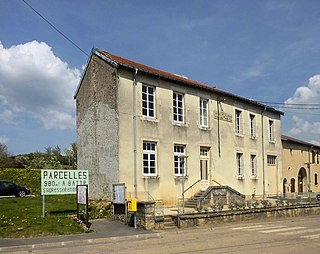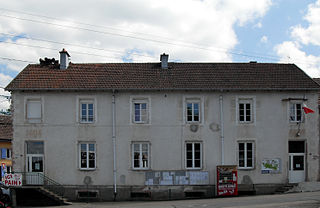
Vosges is a department in the Grand Est region in Northeastern France. It covers part of the Vosges mountain range, after which it is named. Vosges consists of 17 cantons and 507 communes, of which 234 are classified as rural, including Domrémy-la-Pucelle, where Joan of Arc was born. In 2017, it had a population of 367,673 with an area of 5,874 km2 ; its prefecture is Épinal.

Neufchâteau is a commune in the Vosges department in Grand Est in northeastern France.

The arrondissement of Neufchâteau is an arrondissement of France in the Vosges department in the Grand Est region. It has 175 communes. Its population is 53,669 (2016), and its area is 1,817.4 km2 (701.7 sq mi).

Griesheim-près-Molsheim is a commune in the Bas-Rhin department in Grand Est in north-eastern France.

Montbronn is a commune in the Moselle department of the Grand Est administrative region in north-eastern France.

Maconcourt is a commune in the Vosges department in Grand Est in northeastern France.

Martinvelle is a commune in the Vosges department in Grand Est in northeastern France.

Mandray is a commune in the Vosges department in Grand Est in northeastern France.

Mont-lès-Lamarche is a commune in the Vosges department in Grand Est in northeastern France.

Nomexy is a commune in the Vosges department in Grand Est in northeastern France.

Norroy is a commune in the Vosges department in Grand Est in northeastern France.

Pompierre is a commune in the Vosges department in Grand Est in northeastern France.
The Canton of Lamarche is a former French administrative and electoral grouping of communes in the Vosges département of eastern France and in the region of Lorraine. It was disbanded following the French canton reorganisation which came into effect in March 2015. It consisted of 26 communes, which joined the canton of Darney in 2015.
The Communauté de communes des Marches de Lorraine is a French former administrative association of rural communes in the Vosges département of eastern France and on the south-western edge of the region of Lorraine. It was merged into the new Communauté de communes les Vosges côté Sud-Ouest in January 2017.
The Canton of Darney is a rural French administrative and electoral grouping of communes in the Vosges département of eastern France and in the region of Grand Est. The Canton of Darney has its administrative centre at Darney.

The Vôge plateau is a sandstone plateau in north east France, straddling the departments of Vosges and Haute-Saône, between Vittel, Saint-Loup-sur-Semouse and Remiremont. It covers approximately 700 km² of Lorraine and Franche-Comté, and includes the towns of Xertigny, Darney, and Bains-les-Bains.
The Maquis des Vosges were groups of French resistance fighters in the Department of the Vosges during the Second World War. They were associated through an amalgamation of different resistance groups roughly when the Conseil national de la Résistance was created on 27 May 1943. Maquis shrubland is a Mediterranean biome of dense scrub, which provided the guerrillas with cover.
Les-bains or Les bains, usually indicating the presence of a spa, may refer to:
The Apance is a river in the East of France. It is one of the main tributaries to the Upper Saône from the Grand Est region. It is 34.4 km (21.4 mi) long.
The Communauté de communes des Vosges côté Sud-Ouest is an administrative association of rural communes in the Vosges department of eastern France. It was created on 1 January 2017 by the merger of the former Communauté de communes des Marches de Lorraine, Communauté de communes du Pays de la Saône Vosgienne, Communauté de communes du Pays de Saône et Madon and the commune Grandrupt-de-Bains. It has its administrative offices at Darney.
















